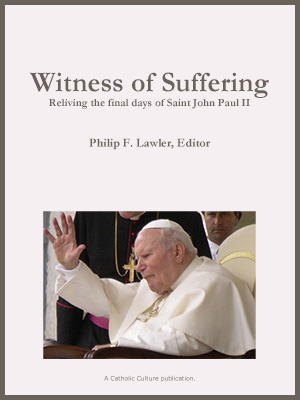Vatican newspaper highlights papal opposition to death penalty as ‘total’ reversal in direction
April 09, 2025
In two articles in its April 8 edition, the Vatican newspaper lamented the extent of capital punishment in the world today and highlighted papal opposition to the practice in recent decades.
Free eBook:

|
| Free eBook: Witness of Suffering |
In a prominent front-page article, “Mai così tante condanne a morte come nel 2024“ [Never so many death sentences as in 2024], Guglielmo Gallone examined Amnesty International’s new report, “Death sentences and executions in 2024.”
“1,518: this is the enormous, dramatic number of people sentenced to death globally in 2024,” Gallone began. “A figure that, on the one hand, is the highest since 2015, but on the other hand, shows that the number of States that have carried out death sentences is the lowest ever recorded. A timid hope, this last one, which however must deal with a much broader and bloodier reality, especially in an area as complex as that of the Middle East. This is where, according to Amnesty International, the highest number of death sentences is concentrated.”
Citing the Amnesty International report, Gallone noted that the figure of 1,518 executions “does not include the thousands of people believed to have been executed in China, which continues to be the state with the world’s highest number of executions, as well as in North Korea and Vietnam, where the death penalty is believed to still be widely used.”
Gallone concluded that there are “clear signs that change is possible, as witnessed at the UN where, for the first time, more than two-thirds of member states voted in favor of the resolution for a global moratorium on the death penalty. It is no coincidence that this sign of hope arrived last December 17, on the eve of the Jubilee, the year of hope.”
Papal teaching
In the second article, “La pena di morte e quel no sempre più forte dei Papi” [The death penalty and the ever stronger no of the Popes], Salvatore Cernuzio compared the teaching of the Council of Trent with recent papal teaching. In doing so, he characterized recent teaching as a total reversal of the “direction” of Catholic teaching, rather than as a development of that teaching or as a series of papal prudential judgments on the application of the traditional teaching in contemporary circumstances.
Cernuzio began:
From the Catechism of the Council of Trent, according to which with a death sentence judges become “executors of divine law,” to Spes non confundit, in which Pope Francis stigmatizes the death penalty as a “provision at odds with Christian faith and one that eliminates all hope of forgiveness and rehabilitation,” about 500 years have passed. And, in between, many changes in social, political, mentality and common law [have occurred] that, in some way, have influenced the Magisterium of the Church. A Church that has not always been against capital punishment, as can be seen from the above sentence from the Tridentine Catechism.
The direction has totally reversed in recent centuries, and all the popes of the 1900s have condemned this practice, still widespread in many countries in Africa and the Middle East, as well as in the U.S.
Following his assertion that “all the Popes of the 1900s” condemned capital punishment—an assertion difficult to reconcile with the historical record, as documented in a 2001 article by Cardinal Avery Dulles, SJ—Cernuzio wrote that “certainly Francis was the Pope of the ‘turning point’ in this sense when, through a 2018 rescriptum, he approved the modification to number 2267 of the Catechism of the Catholic Church relating to the death penalty.”
“Jorge Mario Bergoglio’s very clear position is the result of a journey started by his predecessors, supported by changes, clarifications and ‘refinements’ of the Church’s teaching on this delicate point formulated for the first time in the edition of the Catechism published in 1992,” Cernunzio continued, as he recalled the difference between the 1992 first edition of the Catechism of the Catholic Church, written in French, and the definitive 1997 Latin edition, as well as various texts and appeals by Pope St. John Paul II. “We can therefore attribute to Pope Wojtyla a first new ‘sensitivity’ on the part of the Church on the issue.”
“Benedict XVI went in the same direction,” Cernunzio added, “in the Compendium of the Catechism published in 2002.” The Compendium—actually published in 2005—states:
The punishment imposed must be proportionate to the gravity of the offense. Given the possibilities which the State now has for effectively preventing crime by rendering one who has committed an offense incapable of doing harm, the cases in which the execution of the offender is an absolute necessity “are very rare, if not practically non-existent.” (Evangelium Vitae). When non-lethal means are sufficient, authority should limit itself to such means because they better correspond to the concrete conditions of the common good, are more in conformity with the dignity of the human person, and do not remove definitively from the guilty party the possibility of reforming himself. (n. 469)
“Three different Popes, one same thought,” Cernuzio concluded.
For all current news, visit our News home page.
All comments are moderated. To lighten our editing burden, only current donors are allowed to Sound Off. If you are a current donor, log in to see the comment form; otherwise please support our work, and Sound Off!
-
Posted by: Crusader -
Apr. 09, 2025 12:00 PM ET USA
The pope and the bishops may be "opposed" to the death penalty, but they cannot say that it is immoral. For over 1900 years the Church taught that the death penalty was moral, admissible, and sometimes necessary. This had nothing to do with the unavailability of adequate prisons. When the bishop presenting the new term "inadmissible" to the bishops was asked by a bishop what the word meant he said that it was an example of "exquisite ambiguity." But ambiguity does not belong in a catechism.






